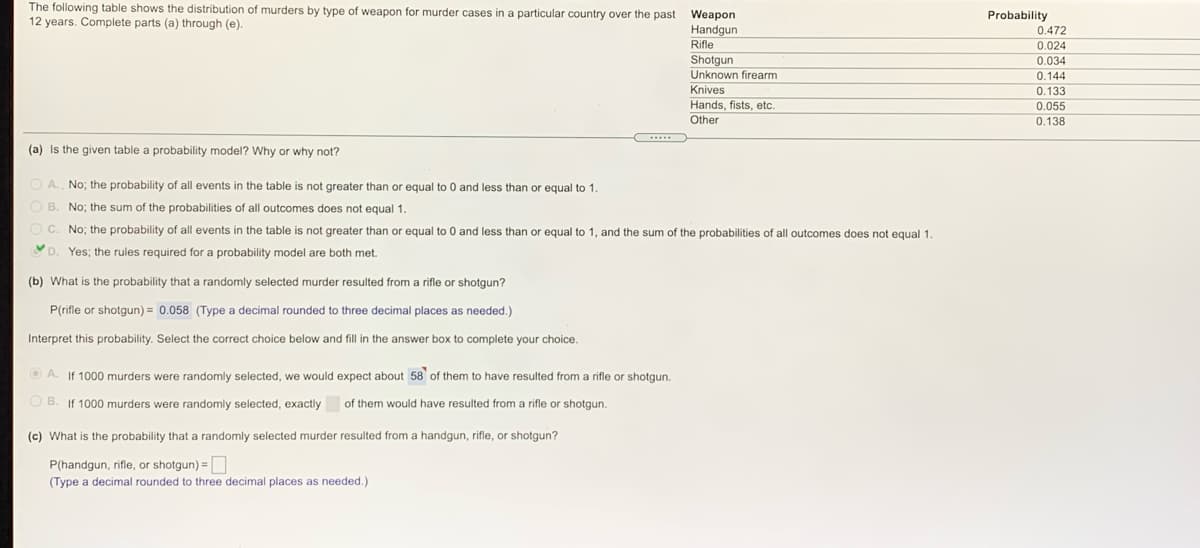The following table shows the distribution of murders by type of weapon for murder cases in a particular country over the past Weapon Handgun Rifle Shotgun Unknown firearm Probability 12 years. Complete parts (a) through (e). 0.472 0.024 0.034 0.144 Knives Hands, fists, etc. 0.133 0.055 Other 0.138 (a) Is the given table a probability model? Why or why not? O A No; the probability of all events in the table is not greater than or equal to 0 and less than or equal to 1. O B. No; the sum of the probabilities of all outcomes does not equal 1. O C. No; the probability of all events in the table is not greater than or equal to 0 and less than or equal to 1, and the sum of the probabilities of all outcomes does not equal 1. D. Yes: the rules required for a probability model are both met. (b) What is the probability that a randomly selected murder resulted from a rifle or shotgun? P(rifle or shotgun) = 0.058 (Type a decimal rounded to three decimal places as needed.) Interpret this probability. Select the correct choice below and fill in the answer box to complete your choice. O A. If 1000 murders were randomly selected, we would expect about 58 of them to have resulted from a rifle or shotgun. OB If 1000 murders were randomly selected, exactly of them would have resulted from a rifle or shotgun. (c) What is the probability that a randomly selected murder resulted from a handgun, rifle, or shotgun? P(handgun, rifle, (Type a decimal rounded to three decimal places as needed.) r shotgun) =
The following table shows the distribution of murders by type of weapon for murder cases in a particular country over the past Weapon Handgun Rifle Shotgun Unknown firearm Probability 12 years. Complete parts (a) through (e). 0.472 0.024 0.034 0.144 Knives Hands, fists, etc. 0.133 0.055 Other 0.138 (a) Is the given table a probability model? Why or why not? O A No; the probability of all events in the table is not greater than or equal to 0 and less than or equal to 1. O B. No; the sum of the probabilities of all outcomes does not equal 1. O C. No; the probability of all events in the table is not greater than or equal to 0 and less than or equal to 1, and the sum of the probabilities of all outcomes does not equal 1. D. Yes: the rules required for a probability model are both met. (b) What is the probability that a randomly selected murder resulted from a rifle or shotgun? P(rifle or shotgun) = 0.058 (Type a decimal rounded to three decimal places as needed.) Interpret this probability. Select the correct choice below and fill in the answer box to complete your choice. O A. If 1000 murders were randomly selected, we would expect about 58 of them to have resulted from a rifle or shotgun. OB If 1000 murders were randomly selected, exactly of them would have resulted from a rifle or shotgun. (c) What is the probability that a randomly selected murder resulted from a handgun, rifle, or shotgun? P(handgun, rifle, (Type a decimal rounded to three decimal places as needed.) r shotgun) =
College Algebra
7th Edition
ISBN:9781305115545
Author:James Stewart, Lothar Redlin, Saleem Watson
Publisher:James Stewart, Lothar Redlin, Saleem Watson
Chapter9: Counting And Probability
Section9.3: Binomial Probability
Problem 33E: Sick leave probability that a given worker at Dyno Nutrition Will call in sick on a Monday is 004....
Related questions
Question

Transcribed Image Text:The following table shows the distribution of murders by type of weapon for murder cases in a particular country over the past Weapon
12 years. Complete parts (a) through (e).
Probability
0.472
Handgun
Rifle
Shotgun
Unknown firearm
Knives
Hands, fists, etc.
0.024
0.034
0.144
0.133
0.055
Other
0.138
(a) Is the given table a probability model? Why or why not?
A. No; the probability of all events in the table is not greater than or equal to 0 and less than or equal to 1.
O B. No; the sum of the probabilities of all outcomes does not equal 1.
C. No; the probability of all events in the table is not greater than or equal to 0 and less than or equal to 1, and the sum of the probabilities of all outcomes does not equal 1.
D. Yes; the rules required for a probability model are both met.
(b) What is the probability that a randomly selected murder resulted from a rifle or shotgun?
P(rifle or shotgun) = 0.058 (Type a decimal rounded to three decimal places as needed.)
Interpret this probability. Select the correct choice below and fill in the answer box to complete your choice.
O A. If 1000 murders were randomly selected, we would expect about 58 of them to have resulted from a rifle or shotgun.
O B. If 1000 murders were randomly selected, exactly
of them would have resulted from a rifle or shotgun.
(c) What is the probability that a randomly selected murder resulted from a handgun, rifle, or shotgun?
P(handgun, rifle, or shotgun) =
(Type a decimal rounded to three decimal places as needed.)
Expert Solution
This question has been solved!
Explore an expertly crafted, step-by-step solution for a thorough understanding of key concepts.
This is a popular solution!
Trending now
This is a popular solution!
Step by step
Solved in 2 steps with 2 images

Recommended textbooks for you

College Algebra
Algebra
ISBN:
9781305115545
Author:
James Stewart, Lothar Redlin, Saleem Watson
Publisher:
Cengage Learning



College Algebra
Algebra
ISBN:
9781305115545
Author:
James Stewart, Lothar Redlin, Saleem Watson
Publisher:
Cengage Learning

